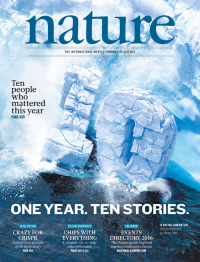Volume 528
-
No. 7583 24 December 2015
The 2015 edition of Nature's 10 � a list of 10 people who mattered in science this year selected by Nature's team of editors � looks behind the major events and discoveries to the human endeavour that makes science work. This year's picks are UN climate chief Christiana Figueres, gene-editing pioneer Junjiu Huang, NASA Pluto specialist Alan Stern, chemical engineer Zhenan Bao, Iran's nuclear engineer/diplomat Ali Akbar Salehi, astronomer and defender of women's rights Joan Schmelz, population geneticist David Reich, superconductivity researcher Mikhail Eremets, synthetic biologist Christina Smolke, and the Reproducibility Project's Brian Nosek. Cover art: Peter Crowther
-
No. 7582 17 December 2015
Male (left) and female Atlantic salmon under Northern lights in the River Alta, Norway, in a double-exposure taken with the same camera, in the same location and on the same night. Craig Primmer and colleagues use genome-wide association studies for age at maturity in Atlantic salmon to show that a single gene, VGLL3, strongly influences the variation in age at maturity, and therefore body size � a key trait in an important fished species. They find that the VGLL3 locus is an example of sex-dependent dominance, promoting earlier and later maturation in males and females, respectively. This mechanism provides a resolution for sexual conflict in this trait, for which selection favours different reproductive ages in the two sexes. Females benefit from being large (5�15 kg), and stay longer at sea feeding by maturing later, while males can have high fitness maturing at smaller sizes (1�3 kg). This discovery will have a substantial impact on population management of Atlantic salmon, where a decrease in the frequency of late maturation has been observed in many populations. Cover: Audun Rikardsen www.audunrikardsen.com
Nature Index
-
No. 7581 10 December 2015
Scanning electron microscopy images of the mechanosensory organs (or hair�) found on the back of wild-type fruit flies (left). Disruption of asymmetric Sara endosome segregation in a sensitized mutant background changes the cellular fate of stem cells producing these bristles and the back of the fly is then naked (right). Asymmetric cell division in which a cell produces two daughter cells with different cellular fates, is a fundamental process common to stem cells in development and beyond. Many fate determinants are partitioned at the cell cortex during asymmetric division, and in a range of cells, a subset of signalling endosomes segregates unequally in the cytoplasm to mediate the distribution of Notch/Delta signalling molecules between the daughter cells. How this asymmetric distribution is achieved was unknown. Marcos Gonzalez-Gaitan and colleagues now show that, during asymmetric division, central spindle asymmetry is generated by the kinesin Klp10A and its antagonist Patronin, which in turn polarizes the direction of endosome motility. The authors were able to direct the endosome to the wrong cell by inverting the central spindle polarity using an antibody-mediated approach. The system described here is one that can target intracellular cargoes in general, and signalling endosomes in particular, to one of the daughter cells during asymmetric division.
-
No. 7580 3 December 2015
Tough growing conditions in polluted ground in Dhaka, Bangladesh, 4 November 2013. This issue of Nature � in recognition of what the UN Food and Agriculture Organization has designated the International Year of Soils � presents a series of Perspectives that discuss the make-up and functions of soils, their influence on the environment and human health, and how sustainable soil management might be achieved in the future. In a Comment piece, Luca Montanarella makes the case for a voluntary international agreement to protect soils worldwide. All four articles are part of Soil and its sustainability� (www.nature.com/soils), a collection of articles related to soil research published in Nature Publishing Group journals during the past year. Cover: Mehedi Hasan/Demotix/Corbis
Nature Outlook




